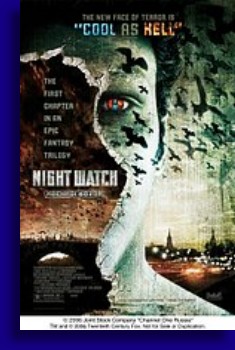




Reviewed by
Bud Carlson


Night
Watch is not your average vampire movie. It’s a
cool, dark,
Russian, almost art-house version of a vampire
movie. The fantasy of
the movie doesn’t come from giant drooling beasts
chasing after
and slaughtering innocent people, nor does it come
from an epic battle
between beasts with fur and beasts with fangs.
Instead, the fantasy
comes from the weird tensions between good and evil,
and the oh-so-cool
images that the movie uses to portray them.
But
before we talk about what this movie is, let’s talk
about what
it’s not. First, it’s not “the Russian Matrix”
as so many online bloggers and chatroom geeks have
hypothesized. In
fact, other than its dark nature and bleak portrayal
of the world, it
couldn’t be any more different. And second, it’s not
“the new face of terror” either (as the movie
posters all
acclaim), as the movie is good enough that it
doesn’t have to
stoop to the levels that most horror movies do these
days. This film
isn’t “good-like-Blade”, it’s
“good-like-Hitchcock”. That’s because it’s able
to get done with one freaky image, what it takes
most other films two
explosions, a severed head and a car chase to
portray. Don’t get
me wrong, that other stuff is good too (I mean who
doesn’t like
car chases and beheadings!), but Night Watch finds
other, more original
ways to get it done. In fact, throughout this movie,
there isn’t
a single silver cross wielded, a single neck bitten,
and no one wears a
cape. Remember the music videos put out by the rock
band Tool back in
the 1990’s? Night Watch has those same weird vibes.
Night Watch is based on the first in a trilogy of novels about supernatural beings called Others. Others are like humans only they have certain powers that humans don’t (most are vampires, but some are shape-shifters, witches, and fortune tellers). The


Others
are born into the world as being neutral, and only
as their
supernatural powers develop do they make the choice
between becoming
Light Others (good guys) or Dark Others (bad guys);
this is a decision
that each individual Other must make for himself, of
his own free will.
Rules exist between the two forces governing such
things as to how
“undeclared” Others can be recruited to either side.
And
for centuries, there has been an uneasy truce among
the two types of
Others (think of it as a supernatural Cold War), but
we learn that
something big is brewing, and that the long-standing
truce is likely
hanging in the balance.
Night
Watch begins with a flashback to 12 years ago, when
Anton Gorodetsky
(played by Konstantin Khabensky) innocently enough
goes to see a witch,
wanting her to conjure up a spell to punish his
cheating girlfriend (he
believes she’s pregnant with another man’s baby).
Anton is
not aware that he is an Other at that time, but the
witch knows, and
tries to get Anton to commit to the side of the Dark
Others in exchange
for her performing that spell, which would be a
clear violation of the
terms of the truce. That witch is promptly arrested
and her spell
reversed. Now,
fast-forward 12 years to
modern day Moscow, and we find Anton is a “field
agent” for
the Light Others, hunting erratic Dark Other
vampires who break the
truce and try to feed on unsuspecting mortals.
Anton’s battle
against true evil begins when he accidentally kills
a vampire while
trying to stop him from feasting on an innocent
young boy. The 12 year
old Yegor (played by Dmitry Martynov) escapes with
his life, but the
vamp’s girlfriend isn’t willing to let the matter
drop.
This kicks off Anton’s journey into and out of The
Gloom, a
surrealistic, hazy, sleep-like state that is
extremely dangerous to
Light Others. Did I mention that vortex of evil is
about to open, and
usher in the apocalyptic end to humanity? Oh,
but wait, I’m getting ahead of myself, and I am
absolutely not
going to give too much of this movie away … you must
go see it
for yourself!
The
drab dank setting of Russia adds a lot to the film,
as does the fact
that the movie is a Russian-language film (with
super-cool subtitles
that seem to come to life and add another dimension
to the appearance
of the movie). The acting is very solid (though it
is often difficult
to determine who is speaking during quick exchanges
if you are reading
the subtitles), and the characters are
more-than-interesting enough
(including Bear and Tiger-Cub who are
shape-shifters, the owl-sorceress
Olga, and Anton’s stoic boss who monitors the
activities of all
the Dark Others and maintains a library of all of
the world’s
myths). Special effects
are used somewhat
sparingly (at least compared to what we have seen
from the more recent
films of this genre), but this serves to make what
effects are used
appear that much cooler and more relevant to the
story. The action
scenes are top-notch, and the film moves at a
break-neck pace,
resisting the urge to dwell on some of the “holy
crap, what did I
just see?” images that really capture your
imagination. But it is
the classic story of good-versus-evil that carries
the movie, with the
sense that something big is about to happen.
Armstead’s Second: When grand ambition meets with less than grand execution, you have Night Watch. This film had some great touches to it, such as the drab stylized look of Moscow, the incredibly clever use of interactive subtitles, and the reliance more on story than on special effects (I looking at you ‘Underworld’). But for me, the movie seemed a bit too slow and deliberate, and the story far too complex than it needed to be. Though I admired much of the film, I can’t jump on board and give it a ringing endorsement. If this is the first of a trilogy, I will be excited to see a much-improved part two.
